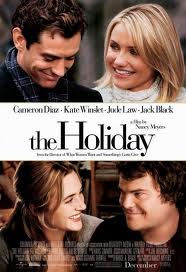Knowing how to cut pages from your screenplay is an essential screenwriting skill–especially for beginners.
To have a chance of selling, your script must fall within acceptable industry lengths (90-100 for a comedy, 110-120 for a drama).
If you’re an unknown writer, a screenplay that’s too long is like including a giant card with your script which says, “I’m an amateur.” If you’re a known writer with a track record…well, that’s a different story.
Screenwriters like James Cameron, Quentin Tarantino, and Nancy Meyers can get away with super-long scripts. Everyone’s still dying to read them. Before you ascend to their heights however, you’ve got to master the art of trimming your screenplay, page by page, degree by degree.
This article will show you how–with concrete examples from The Holiday, the romantic comedy starring Kate Winslet & Cameron Diaz and written & directed by Nancy Meyers. If you exclude the credits, it has a running time of 130 minutes.
That’s longer than the average drama. (To Meyers’s credit, for the most part, it doesn’t feel too long.)
When I sat down to watch the romantic comedy this year, I watched it with the intention of looking for ways to whittle it down to about 105 minutes. That’s still fairly long for a romantic comedy.
But The Holiday is unique in that it features two heroines with storylines of equal weight. Trying to cut the movie even more would require turning one of the storylines into a subplot, which I didn’t want to do.
Doing this little exercise taught me A LOT.
First of all, let me say, it was bloody hard.
I had become attached to various little moments, even though I hadn’t written them. I can only imagine how Meyers felt in the editing room.
(In the middle of writing this article, I started watching the movie with her director’s commentary on, and I learned that she had already cut the movie’s running time by an hour. After having to be so brutal, I can see why she was loathe to trim anymore.)
Secondly, it’s extremely easy to justify keeping everything. Some of the rationalizations I came up with:
- This is essential to set the mood.
- I can’t cut this funny bit. A romantic comedy is supposed to have comedy.
- I’ll lose the Jude Law eye candy
- If I reduce Arthur’s lines anymore, I won’t get an awesome actor to play him
- If I cut down Iris’s monologues, can I still attract A-List talent to play her?
To the last two objections, I told myself: “if I don’t cut this screenplay by 25 pages, I won’t have to worry about casting at all because the movie won’t get made.” This kind of thinking strengthened my resolve, and I resumed cutting and trimming with renewed vigor.
Finally, I learned that you have to delight in the small cuts of 10, 15, or 20 seconds because they DO add up.
I was rarely able to eliminate scenes wholesale. Many of my cuts amounted to a few lines of dialogue…the equivalent of 10-15 seconds onscreen. It didn’t feel like I was doing much to reach my desired goal.
But because I made so many miniscule trims, the seconds added up to several minutes…25, to be precise.
How did I do it?
Basically, I made cuts–some long, most short–which roughly fell into 5 major categories:
- Shortening long scenes, sequences & speeches
- Keeping scenes as thin as possible
- Letting go of mood/setting
- Decreasing the dialogue of side characters
- Letting go of comic grace notes
Examples from each category are below. Studying these examples should help you understand how to apply the same principles to your own script, regardless of it’s a romantic comedy or not. (For more approaches, check out John August’s very helpful article How to Cut Pages.)
To make what I did really clear, I’ve written out a few scenes, striking through the lines I cut and rewriting lines to make smooth transitions (if needed).
Note: you’ll notice that these categories can overlap. I organized my examples according to which reason was at the forefront of my mind when I made the cut.
Unfortunately, I wasn’t able to locate a copy of the original script. The scenes written out below were created by me putting what I saw/heard onscreen into screenplay format. They are not what Nancy Meyers actually wrote (except for the dialogue, of course). Even if you haven’t seen the movie, these examples are easy to follow.
However, I couldn’t write out word-for-word every cut I made. I’ve summarized most of them with a one-line description, plus a time indicator. You really have to watch the movie to understand these examples. Since The Holiday is a charming romantic comedy–why not give it a try?

Before I get to the examples, I should admit I prefer Meyers’s full-length version to my redux.
But it bears repeating: she can get away with a 2+ hour romantic comedy.
You can’t.
So let’s get cutting!
Screenplay Cutting Technique #1: Look for the long S
Flip through your script and look for any scene, sequence, or speech which runs long. Select a logical place to end it. And make the cut.
It will be difficult. Usually those long speeches and scenes will turn out to be your favorites. But honestly, it’s a rare scene which requires more than four pages or a monologue which requires 200+ words to make its point.
The problem is that you’ve convinced yourself each line is absolutely necessary. Now, you’ve got to convince yourself that no one will see a single line if you don’t make ruthless cuts.
Screenplay Example: Iris’s voiceover
The Holiday begins with an extraordinarily long voiceover by Kate Winslet’s character, Iris. Going into this project, I knew right away I’d have to trim this down.
While I appreciate Iris’s observations, and the montage-style introduction to the central characters, the only essential detail that a reader needs to know is that Iris suffers from unrequited love.
Once I identified that as the essential point, it became much easier to trim down the film’s beginning. When I finished, I had shortened the scene by 2.5 minutes!
EXT. FOREST – DAY
A man and a woman kiss each other, the kind of kiss you find in fairy tales.
REVEAL the couple is on a computer screen. We’re not in a forest, but in a
HOME STUDIO
where MILES, a scruffy musician with a good heart, is composing a score for the romantic scene.
IRIS (V.O.)
I have found almost everything ever written about love…to be true.
Miles’s girlfriend, MAGGIE, giggles into her cell phone.
IRIS (V.O.)
Shakespeare said, “Journeys end in lovers meeting.”
Miles stares at Maggie in awe. How did he get so lucky?
IRIS (V.O.)
Ah, what an extraordinary thought.
To say good-bye Miles drops an old-fashioned kiss to Maggie’s fingers. She’s not into old-fashioned, but she tries, for Miles’s sake.
IRIS (V.O.)
Personally, I have not experienced anything remotely close to that. But I’m more than willing to believe Shakespeare had. I suppose I think about love more than anyone really should. I’m constantly amazed by its sheer power to alter and define our lives.
Maggie exits.
IRIS (V.O.)
It was Shakespeare who also said, “Love is blind.” Now, that is something I know to be true.
INT. EXPENSIVE CAR – DAY
Cold as the Arctic in here. From the passenger seat, AMANDA scornfully glances at her boyfriend, ETHAN. Vulnerability hides underneath her icy, professional exterior.
IRIS (V.O.)
For some, quite inexplicably…love fades.
INT. BEDROOM – NIGHT
An elderly man, ARTHUR, switches off a lamp, which rests on a nightstand cluttered with photos from the past.
IRIS
For others, love is simply lost.
INT. BRITISH PUB – NIGHT
GRAHAM, too handsome for his own good, expertly navigates his way through a cheerful crowd.
IRIS (V.O.)
But then of course, love can also be found.
Graham makes eye contact with a girl.
IRIS (V.O.)
Even if just for the night.INT. NEWSPAPER OFFICE – NIGHT
At a cluttered desk, IRIS wraps a Christmas present with a critical eye usually reserved for her newspaper column.
In her 30s, she has the kind of rose-cheeked beauty–and romantic outlook–found in Austen novels.
IRIS
Unrequited love.
And there’s another kind of love.The cruelest kind.The one that almost kills its victims. It’s called unrequited love.Of that, I am an expert. Most love stories are about people who fall in love with each other. But what about the rest of us? What about our stories?
Screenplay Example: Iris’s monologue to Miles
Another prime candidate for cutting comes from Iris again. This time, it’s a long speech she delivers to Miles after he catches his girlfriend on a date with another man.
When I assessed Iris’s monologue, I looked for a place I could logically stop and still maintain the same emotional note.
INT. AMANDA’S LIVING ROOM – NIGHT
Iris stands, resolved not to let this setback ruin her Christmas–or Miles’s.
IRIS
So how about some food? Shall I make us a little Christmas fettuccine?
MILES
(resigned)
Sure.
IRIS
Listen. I know it’s hard to believe people when they say, “I know how you feel.” But I actually know how you feel. You see…
Now she sinks into the plush sofa…
IRIS
…I was…seeing someone back in London. We worked for the same newspaper. And then I found out that he was also seeing this other girl, Sarah…from the Circulation Dept on the 19th floor. It turned out that he wasn’t in love with me like I thought. What I’m trying to say is…I understand feeling as small and as insignificant as humanly possible. How it can actually ache in places that you didn’t know you had inside you. It doesn’t matter how many haircuts you get or gyms you join or how many glasses of chardonnay you drink with your girlfriends. You still go to bed every night going over every detail and wonder what you did wrong or how you could have misunderstood.
And how in the hell, for that brief moment, you could think that you were that happy? And sometimes you can even convince yourself that he’ll see the light and show up at your door. And after all that, however long “all that” may be, you’ll go somewhere new. And you’ll meet people who make you feel worthwhile again. And little pieces of your soul will finally come back. And all that fuzzy stuff, those year of your life that you wasted, that will eventually begin to fade.Miles exhales, hands Iris the vodka.
MILES
You need this more than I do.
More examples:
Here is a list of other moments I was able to cut from the script by zooming in on long scenes, sequences, and speeches:
- 10 secs – Iris’s elaboration on unrequited love/the walking wounded [3:09 – 3:19]
- 20 secs – More on the worst years of Iris’s life [3:23 – 3:43]
- 20 secs – Discussion of Amanda and Ethan’s problems [12:10 – 12:30]
- 10 secs – Amanda’s meltdown in front of her staff [starting ard 17:30]
- 30 secs – Search for vacation rental [19:30 – 19:60]
- 160 secs – Amanda and Graham in gardens/Convo in car [1:08:55 – 1:11:35]
- 30 secs – Amanda breaking up with Graham [1:48:30 – 1:49:00]
Screenplay Cutting Technique #2: Cut your scenes like a deli slicer
Screenwriting 101: get in late and leave early. Here’s Alex Epstein’s take, as described in his writing guide, Crafty Screenwriting:
Get into your scene as late as you can, make your point, and get out as soon as you can.
On the simplest level, don’t show the guy coming in the door…after a page or two of brilliant dialogue ending with Max agreeing, “what could possibly go wrong?” cut straight to what goes wrong.
Don’t let the scene trail off with the guys shaking hands and Carl going out the door.
Screenplay Example: Iris and Arthur go out for dinner
Beginning screenwriters are likely to show Iris and Arthur going to their table and giving their order to the waitstaff. As a pro, Meyers doesn’t waste time with small pleasantries, and begins the scene in the middle of their dinner.
Unfortunately, if you want to make your scenes as thin as deli meat, you don’t have time to dwell on Arthur’s glory days, as adorable as he is.
INT. FANCY RESTAURANT – NIGHT
Waiters bustle in between tables clothed in white linens. At a cozy table, Arthur and Iris chat like old friends.
ARTHUR
I learned everything working in this place. Best job I ever had.
IRIS
Wait, wait, wait. That was your first job in Hollywood. Louis B Mayer’s office boy?
ARTHUR
Actually, my first job was as a Western Union messenger. That’s how I met Mayer. I delivered a telegram to his office at MGM. When I walked in, all the girls in the office were in a tizzy. Their office boy didn’t show up. I volunteered for the job. The next day, I was on the payroll. I was 17 years old.IRIS
Wow. So was Hollywood really as great back then as I imagine?
ARTHUR
It was better. You know what I’ve been asking myself all night?
IRIS
What? Why I’m bothering you with all these questions?
ARTHUR
I’m wondering why a beautiful girl like you would go to a stranger’s house for her Christmas vacation, and on top of that, spend Saturday night with an old cocker like me.
The scene concludes with Arthur causing Iris to make a key realization: she doesn’t live her life like a leading lady…but like a best friend.
For Arthur’s advice to have maximum impact, we should know that he’s a Hollywood veteran. But we don’t need the Louis B Mayer anecdote. Arthur’s credibility has already been established 1) when Iris discovers all the awards in his office and 2) when Arthur describes their run-in as a “meet-cute.”
Screenplay Example: The awkward morning after
Amanda and Graham have slept together for the first time. But they don’t really know each other. Naturally, the morning after’s a bit awkward (but still cordial).
Graham gives Amanda a practiced brush-off…which Amanda says isn’t necessary. She promises she won’t fall in love with him. Most of the conversation which follows isn’t essential. To understand the scenes which come later, we just need to keep one bit: the invitation.
INT. IRIS’S COTTAGE – DAY
Amanda and Graham awkwardly chat in the kitchen.
GRAHAM
Well, I just want to be sure you are okay because somehow I find I tend to hurt women simply by being myself, so–
AMANDA
I’m not going to fall in love with you, I promise.
GRAHAM
Okay, nicely put. Thank you.
AMANDA
It’s just that I know myself. I’m not even sure I fall in love. Not in the way other people do. How’s that for something to admit?
GRAHAM
Well, like I said, Most Interesting Girl Award.
AMANDA
I’m going to try to see that as a compliment.
GRAHAM
You should. Absolutely.
GRAHAM
Right. Okay, then. Well.
Graham wanders into the living room and shrugs into his jacket. Amanda remains in the kitchen.
GRAHAM
Utter honesty. Very refreshing. Well, you probably won’t be hearing from me…because even if you wanted to, which you clearly don’t, I have the classic male problem of no-follow through. Absolutely never remember to call after a date. But since this wasn’t a date, then I guess I’m off the hook.
AMANDA
Exactly.
Graham charges back into the kitchen.
GRAHAM
But what if I wanted to call you?
Amanda makes non-committal sounds.GRAHAM
Right. Sorry. Apparently not the right thing to say at all.Well, if your flight’s canceled, or if for some reason, you change your mind, I’m having dinner with some friends at the pub tonight. And…if not, then, well…you’re lovely.AMANDA
(semi-reluctantly)
So are you.
More examples:
Here are different scenes I tried to cut as slim as deli meat!
- 15 secs – Cut to “I’ll send you your things” [12:50 – 13:05]
- 30 secs – Graham owns a cow [1:27:35 – 1:28:05]
- 45 secs – Cut to Iris handing Arthur his mail [1:28:05 – 1:28:50]
- 85 secs – Cut to “2 notes and you’ve got a villain” [1:33:50 – 1:35:15]
- 45 secs – Discussion of old movies [1:49:00 – 1:49:45]
- 30 secs – Cut everything after “don’t worry” [1:51:10 – 1:51:40]
- 20 secs – Cut to “you will look at me eventually” [1:52:50 – 1:53:10]
Screenplay Cutting Technique #3: Get rid of mood setters
Scenes which establish a scene’s setting and/or mood may be gorgeous (and many in The Holiday are), but they rarely push the story forward.
These should be the easiest cuts for you to make. (Well, unless you’re a novelist-turned-screenwriter.)
Screenplay Example: Iris’s reaction to Jasper’s engagement
After Iris learns that Jasper is engaged to be married, she trundles through London in a teary daze. I actually love this montage very much…but had to accept that it’s not 100% necessary. Just hearing the sound of Iris weeping behind the closed doors of her cozy cottage gets the message across.
EXT. LONDON STREET – NIGHT
Bundled up against the chill, Iris trudges on the embankment across from the Houses of Parliament. Their bright lights contrast with her dark thoughts. How could she have been so stupid?
INT. LONDON TRAIN – NIGHT
Iris stares into the distance.
EXT. SURREY VILLAGE – NIGHT
Iris shuffles down the sidewalk of a village, dark except for lampposts and Christmas tree lights.EXT. ROSEHILL COTTAGE – NIGHT
She approaches a low stone fence. It encloses a SMALL COTTAGE straight out of a Thomas Kincaid painting.
She unlocks the cottage’s gated entrance. Bells TINKLE. Wearily, she ascends a set of steps and makes her way inside.
Once she closes the door, we hear the sound of WEEPING.
Screenplay Example: Iris’s tour of Amanda’s home
When Iris arrives at Amanda’s McMansion, Iris conducts a thorough investigation. Each room seems to delight her more than the last. Again, I love the way Iris looks like a little kid in a candy shop…but we don’t need to see her explore the house room by room.
The script already established Amanda’s house is amazing from the very first scene with Amanda and Ethan…which means that we can cut to each luxurious room when they actually play a role in the plot. It’s not necessary to set them up beforehand in a grandiose tour.
EXT. AMANDA’S LA HOME – DAY
A taxi pulls away from a massive gated entrance. Iris gazes at it, in awe of the mansion in front of her.
IRIS
Holy ****.
The front door opens, revealing:
INT. AMANDA’S FOYER – DAY
Mouth agape, Iris crosses the threshold. In disbelief, she twirls in a circle…
then peeks into the
LIVING ROOM
At its sleek design, Iris does a happy dance.
EXT. BACKYARD POOL – DAY
Iris rushes towards a massive pool. A few inches from its ledge, she jumps in the air, like a nervy rock star.
INT. AMANDA’S KITCHEN – DAY
It’s bigger than a studio apartment. Iris races through it in a whirlwind…finding herself in a
SPACIOUS DEN
with a flatscreen TV and more DVDs than a Blockbuster. Iris’s giddiness multiplies. Next stop: the
HOME GYM
complete with all the trendiest exercise machines.
Iris floats up the main STAIRCASE, discovers a tidy HOME OFFICE…and then jackpot!
THE BEDROOM
With glee she pounces on top of the bed, like a reverse snow angel.
More examples:
Here are more examples of how I cut scenes like a Grinch who stole mood lighting:
- 35 secs – Panorama of Malibu [26:45 – 27:20]
- 30 secs – Amanda and Graham exchanging looks in the car [1:05:10 – 1:05:40]
- 25 secs – Graham’s longing glance [2:04:05 – 2:04:30]
- 25 secs – Part of Amanda’s run through the snow [2:06:20 – 2:06:45]
- 10 secs – Part of New Year’s Eve celebration [2:09:00 – 2:09:10]
Screenplay Cutting Technique #4: Eliminate screentime of minor characters
If you’re really desperate to shorten your screenplay, start paying close attention to your side characters. Since they aren’t the main engine of your story, you can usually trim their scenes without having to rework your entire plot. Be forewarned: if you’ve gotten attached to one of your side characters, this can be extremely difficult.
In the case of The Holiday, I had to eliminate several lines of Arthur’s dialogue, and he was one of my favorites. It was just easier to cut his lines than to rework scenes with the main characters (Iris, Amanda, and Graham).
More examples
Here are more examples of dialogues belonging to minor characters which I cut. For some reason, I lump Jack Black’s character, Miles, into the side character category, even though I’m sure Meyers conceived him as a main character.
- 10 secs – Iris’s conversation with Jasper [starting ard 6:00]
- 10 secs – Ethan waking up on the sofa [starting ard 11:00]
- 35 secs – Santa Anas/Meeting Maggie [36:45 -37:10, plus 10 secs]
- 30 secs – Arthur’s description of houses/Iris spying into office [56:35 – 56:55, plus 10 secs]
- 40 secs – Discussion Arthur’s wife, Marion [1:12:40 – 1:13:20]
- 35 secs – Maggie’s apology to Miles [1:54:15 – 1:54:50]
- 80 secs – Arthur and the corsage [1:57:45 – 1:59:05]
- 45 secs – Arthur’s comments about the box office [2:01:15 – 2:02:00]
Screenplay Cutting Technique #5: Cut humorous moments
By humorous moments, I mean comic grace notes, not full-fledged comedy gags. Basically, you want to eliminate sprinkles of humor which really don’t push the story forward. Of course, you’ve got to be careful not to go overboard with this cutting technique.
The Holiday IS a romantic comedy, which means it has to deliver on both elements. If you remove too many lighthearted grace notes, the script will feel as a dry as a digestive biscuit.
Even with a drama, you can’t cut all the comedic elements from it. Then there’s nothing to relieve the emotional tension, and your script will make people feel anxious instead of appreciative.
This is probably the category where you want to do the most reassessment afterwards. Once you make your cuts, have you ended up creating a sterile script? If so, you might have to insert a few of these comic moments back in–and use the other four methods listed above to trim your screenplay.
Screenplay Example: Iris’s flight
When Iris boards her transatlantic flight, she thinks she’s going to sit next to a handsome guy…but naturally, that kind of luck isn’t on her side.
This little comedy bit is just the kind of scene I can see myself being enormously reluctant to cut if I had written it. It’s adorable…but with the exception of Jasper’s text message, it doesn’t drive the plot forward.
INT. AIRPLANE – DAY
Iris settles into her coach chair. The seats on either side of her are vacant.
A MAN (tall, dark and handsome) approaches Iris’s row. In preparation to sit, he removes his coat.
HANDSOME MAN
Hi.
Iris beams. Things are looking up.
IRIS
Hi.
HANDSOME MAN
How are you?
IRIS
Fine.
A PRISSY WOMAN appears behind the handsome man. She points to the row behind Iris’s.
PRISS
Honey, we’re sitting there.
HANDSOME MAN
(to Iris)
Oh. Sorry.
The priss shoots Iris a snarky look. Iris gazes at the man longingly, then snorts in self-derision.
Two MIDDLE-AGED LADIES now approach Iris’s row.
BRITISH BUSYBODY #1:
Oh, yes, there it is.
(gaze landing on Iris)
Well, hello dear.
IRIS
Hello.Busybody #1 and #2 jockey into the seats on either side of Iris.
BRITISH BUSYBODY #1:
Excuse me. There we go. I’m so sorry.
BRITISH BUSYBODY #2:
Did you step on her foot?
IRIS
It’s okay.
BRITISH BUSYBODY #1:
Oh dear, clumsy me.Iris’s phones rings, signaling a text message from Jasper.
INSERT – text message:
From: Jasper Bloom
Subject: Heard you left for holiday in Lotus Land.
First vacation in four years is a turning point. I salute you. How do I reach you?
JasperIris gathers her composure, then types a reply. She begins it with “DEAR.” Thinks better of it, starts over.
INSERT – Iris’s reply
Jasper,
We both know I need to fall out of love with you.
Would be great if you would let me try.
More examples
Here are examples of lighthearted comic moments I cut:
- 10 secs – Esophageal spasm [14:08 – 14:18]
- 50 secs – Iris half-heartedly tries to kill herself [20:30 – 21:20]
- 10 secs – Part of Amanda’s jog to Rosehill Cottage [starting ard 28:56]
- 30 secs – Iris falling asleep with the help of Amanda’s shutters [38:45 – 39:15]
- 20 secs – Amanda and Graham and the coffee maker bit [starting ard 48:28]
- 45 secs – Iris dancing in bed [52:55 – 53:40]
More Screenwriting Tips from Nancy Meyers
Red pen and scissors by Steakpinball




















